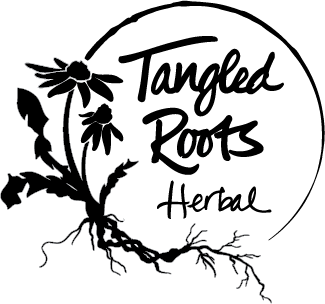Menopause is a sacred (if sometimes sweaty) rite of passage—one that marks the shift from the fertile years into the wise, wild years. But let’s not pretend it’s all moonlit walks and intuitive downloads. Hormonal chaos, mood swings, night sweats, and more can throw even the chillest among us off balance.
Herbs can help—really help—not by replacing your hormones, but by supporting your body’s systems as they adjust. Let’s go a little deeper into how.
🧠 Hormones 101: What’s Actually Happening?
Estrogen and progesterone begin to decline in perimenopause, with estrogen often fluctuating wildly before it gradually drops. Your adrenal glands start producing more of your sex hormones to compensate, but if you’re burned out or stressed? Oof. That transition can feel rough.
You may notice:
-
Vasomotor symptoms (hot flashes, night sweats)
-
Sleep disturbances
-
Cognitive shifts (brain fog, forgetfulness)
-
Mood swings and anxiety
-
Vaginal dryness and low libido
-
Changes in bone density and heart health
This is where herbal support really shines.
🌿 The Herbs & How They Work
Let’s talk about how these plants actually help—not just symptom by symptom, but system by system.
Black Cohosh (Actaea racemosa)
🧪 Phytoestrogenic + Nervine + Antispasmodic
Black Cohosh binds to estrogen receptors and acts as a selective estrogen receptor modulator (SERM). That means it gently mimics estrogen in some tissues (like the brain and bones) without overstimulating others (like the uterus or breast). It also calms the sympathetic nervous system, reducing the intensity of hot flashes and mood swings.
🌿 Use for: Hot flashes, night sweats, mood shifts, muscle tension.
Vitex (Vitex agnus-castus)
🧪 Pituitary Modulator + Hormonal Balancer
Vitex doesn’t contain hormones—it works by nudging the pituitary gland to balance levels of luteinizing hormone (LH) and prolactin, which indirectly helps regulate estrogen and progesterone. It’s particularly helpful in early perimenopause when progesterone tends to drop first, creating estrogen dominance symptoms like irritability and breast tenderness.
🌿 Use for: Cycle regulation, moodiness, tender breasts, PMS-like symptoms.
Dong Quai (Angelica sinensis)
🧪 Blood Builder + Estrogen-Modulating Tonic
In Traditional Chinese Medicine, Dong Quai is considered a tonic for "blood deficiency" and stagnation. It increases circulation to the pelvic region, supports iron levels, and mildly stimulates estrogen receptor activity. It’s often used in blends to harmonize and support hormonal balance.
🌿 Use for: Fatigue, irregular bleeding, low libido, stagnation.
Motherwort (Leonurus cardiaca)
🧪 Nervine + Cardiac Tonic + Uterine Relaxant
Motherwort is all about the heart—physically and emotionally. It supports healthy heart rhythm (hello, palpitations), eases anxiety, and soothes frayed nerves. It's a bitter herb that also mildly tones the uterus, which can be helpful in perimenopause when cramps or breakthrough bleeding are still an issue.
🌿 Use for: Anxiety, panic, heart palpitations, PMS rage.
Ashwagandha (Withania somnifera)
🧪 Adaptogen + Endocrine Support
Ashwagandha supports the HPA axis (hypothalamus-pituitary-adrenal axis), which governs stress and hormone output. It helps restore vitality, improve sleep, reduce cortisol, and enhance thyroid and adrenal function. This is especially key post-menopause, when your adrenals take over hormone production.
🌿 Use for: Insomnia, fatigue, overwhelm, hormonal burnout.
Sage (Salvia officinalis)
🧪 Astringent + Anticholinergic
Sage reduces excessive sweating by modulating acetylcholine—the neurotransmitter that signals your sweat glands to turn on. It also has a cooling and drying quality energetically, making it perfect for people who run hot and damp during menopause.
🌿 Use for: Night sweats, hot flashes, body odor, oily skin/scalp.
Red Clover (Trifolium pratense)
🧪 Phytoestrogen + Lymphatic
Red Clover contains isoflavones—plant compounds that mimic estrogen in a gentle way. These phytoestrogens help ease symptoms related to estrogen decline, and its lymphatic properties support detox and healthy breast tissue. It's nutritive, rich in minerals, and generally very gentle.
🌿 Use for: Skin dryness, joint pain, breast health, gentle estrogen support.
🧘♀️ Putting It All Together: Herbs + Lifestyle
Menopause is not a one-herb-fits-all experience. Supporting the whole person—nervous system, adrenal health, liver detox pathways, and emotional well-being—is where herbalism shines.
Pair herbs with:
-
Nourishing meals (bone broth, healthy fats, leafy greens)
-
Rest and rhythms (yes, sleep hygiene and daily rituals matter)
-
Movement (walking, yoga, strength training)
-
Joy and connection (especially with other wise women)
🌼 Shop + Support from Tangled Roots
💫 Browse our curated Herbs for Menopause Collection
💫 Grab the free printable Menopause Tea Blends Guide
💫 Email me if you have questions!


